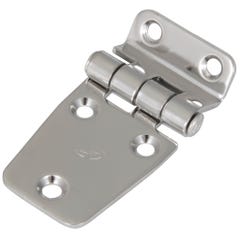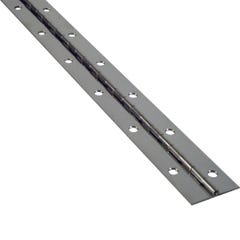Boat Hinges for Doors & Hatches
Core to the operation of most boat doors, lids, and hatches, hinges play a critical role in both support and functionality. » Read More
Learn More About Boat Hinges
Contents
Hinge Selection for New Projects
When selecting hinges for new projects many considerations come into play. Below, we’ll break down those options as well as other factors to be mindful of before making your purchase:
Types of Hinges and Their Common Uses
Hinges play a vital role in enabling movement and stability in doors, cabinets, and furniture. With a range of types available, each hinge serves specific purposes across different applications. This overview highlights common uses and characteristics, helping you choose the right hinge for your project with ease. Read More
Butt Hinges - The most common boat hinge, usually used on livewell lids and hatches, these are available in a wide variety of types, mounting styles, and material compositions.
Piano Hinges - Similar to butt hinges, these are commonly used on console and storage center doors and are offered in both standard as well as friction styles. In addition to marine applications, we often see these hinges used for a wide array of other DIY projects, from furniture making to aquarium lids. In addition to the standard piano hinges we now offer friction style piano hinges which have become the latest go to for most boat builders on their console doors.
Concealed Hinges - Used primarily on cabinet doors, this hinge style provides a hidden look not visible from the outside when the door is closed.
Glass Door Hinges - These hinges are specifically designed to hold a piece of glass by applying pressure on both sides of the material without having to drill through the glass. These are commonly used for glass dividers or partitions as well as on glass shower doors.
Specialty Hinges - In addition to the commonly used hinges above, we also carry a variety of specialty marine hinges that can be used in applications like for ratcheting seat backs as well as quickly securing your bimini top to the boat to name a few.
Hinges play a vital role in enabling movement and stability in doors, cabinets, and furniture. With a range of types available, each hinge serves specific purposes across different applications. This overview highlights common uses and characteristics, helping you choose the right hinge for your project with ease.
Butt Hinges - The most common boat hinge, usually used on livewell lids and hatches, these are available in a wide variety of types, mounting styles and material compositions.
Piano Hinges - Similar to butt hinges, these are commonly used on console and storage center doors and are offered in both standard as well as friction style. In addition to marine applications, we often see these hinges used for a wide array of other DIY projects, from furniture making to aquarium lids. In addition to the standard piano hinges we now offer friction style piano hinges which have become the latest go to for most boat builders on their console doors.
Concealed Hinges - Used primarily on cabinet doors, this hinge style provides a hidden look not visible from the outside when the door is closed.
Glass Door Hinges - These hinges are specifically designed to hold a piece of glass by applying pressure on both sides of the material without having to drill through the glass. These are commonly used for glass dividers or partitions as well as on glass shower doors.
Specialty Hinges - In addition to the commonly used hinges above, we also carry a variety of specialty marine hinges that can be used in applications like for ratcheting seat backs as well as quickly securing your bimini top to the boat to name a few.
You’ve Selected Your Hinge Type, Now What?
Now that you've made your decision on the type of hinge that best fits your needs, it's essential to delve into the finer details to ensure optimal functionality and longevity. Whether you've chosen friction or non-friction hinges, several factors need consideration. Material compatibility, mounting style, and material choice all play crucial roles in ensuring the effectiveness and longevity of your installation. By carefully weighing these factors, you can enhance functionality and make the most of your chosen hinge type. Read More
Friction vs. No Friction
When determining whether or not to use friction style hinges there are a few things to consider. Depending on the material you are installing the hinge to, you will need to ensure the amount of force the friction hinge has will work for your application. If the force is too light, it will potentially not hold as intended. On the other hand, a hinge with too much force may flex, and even break, material with repeated use. Additionally, when using a friction style hinge, it may be best to thru-bolt when installing as the friction can back out fasteners from the material.
Mounting Style
Available in differing mounting styles, selecting the right boat hinge without the pros and cons of each at times can be difficult.
Top Mount - Easiest to install as it requires little to no tooling, but sits proud and can be a stub hazard for unprotected feet.
Flush Mount - Harder to install as it requires tooling into the material in most cases, but installs flush leaving no proud surfaces.
Swaged - This style requires a bit of tooling similar to a flush mount hinge to allow the leaf to recess into the material, but still leaves it sitting slightly proud.
Offset - Specifically designed to add extra clearance, an offset hinge moves the pivot point further from the hinge to increase swing, allowing for more access to the opening.
Material
Material must also be considered when selecting a hinge for your next project. We primarily carry hinges made from stainless steel or plastic. Stainless steel marine hinges are usually more expensive, but give an appealing finished look and will not crack or break as easily as those composed of plastic. That said, plastic hinges may be a better option if you are looking to save a little money and don't need something as durable over time.
Now that you've made your decision on the type of hinge that best fits your needs, it's essential to delve into the finer details to ensure optimal functionality and longevity. Whether you've chosen friction or non-friction hinges, several factors need consideration. Material compatibility, mounting style, and material choice all play crucial roles in ensuring the effectiveness and longevity of your installation. By carefully weighing these factors, you can enhance functionality and make the most of your chosen hinge type.
Friction vs. No Friction
When determining whether or not to use friction style hinges there are a few things to consider. Depending on the material you are installing the hinge to, you will need to ensure the amount of force the friction hinge has will work for your application. If the force is too light, it will potentially not hold as intended. On the other hand, a hinge with too much force may flex, and even break, material with repeated use. Additionally, when using a friction style hinge, it may be best to thru-bolt when installing as the friction can back out fasteners from the material.
Mounting Style
Available in differing mounting styles, selecting the right boat hinge without the pros and cons of each at times can be difficult.
Top Mount - Easiest to install as it requires little to no tooling, but sits proud and can be a stub hazard for unprotected feet.
Flush Mount - Harder to install as it requires tooling into the material in most cases, but installs flush leaving no proud surfaces.
Swaged - This style requires a bit of tooling similar to a flush mount hinge to allow the leaf to recess into the material, but still leaves it sitting slightly proud.
Offset - Specifically designed to add extra clearance, an offset hinge moves the pivot point further from the hinge to increase swing, allowing for more access to the opening.
Material
Material must also be considered when selecting a hinge for your next project. We primarily carry hinges made from stainless steel or plastic. Stainless steel marine hinges are usually more expensive, but give an appealing finished look and will not crack or break as easily as those composed of plastic. That said, plastic hinges may be a better option if you are looking to save a little money and don't need something as durable over time.
Contact Us
If you’re having trouble finding the exact part you're looking for, the best first step is to take a picture and give us a call.
Our customer service team is here Mon-Fri 8am - 5pm and would love to help you track down the exact hardware you need.

Need Help?
Speak to one of our industry pros:
Tap to Call
Commonly Asked Questions About Hinges
Boat hatch hinges are best secured with mechanical fasteners, they are often pre-drilled making mounting easy. Selecting the right mechanical fastener depends on the material and thickness of the mounting surface. If you have any questions, give us a call we will be glad to walk you through the process.
Boat outfitters offers the option to order cut-to-size piano hinges, eliminating the need for you to cut your own. If you prefer to make the cuts, piano hinges can be cut using a clutch grinder.
The main types of marine hinges include; Butt hinges, piano hinges, friction hinges, strap hinges, concealed hinges, and glass hinges.
The best hinge for your project depends on the application and mounting surface, we work with all different applications so give us a call to discuss which hinge is best for you.
Marine grade hinges are composed of corrosion-resistant materials like stainless steel or plastic. These options are common for boat hinges since they are designed for the harsh marine environment.
No, friction hinges are not adjustable. Some of our friction hinges appear to have an opening to be adjusted with an allen wrench, but that is not the case. Friction hinges are not able to be adjusted and trying to do so will damage them. While friction hinges aren’t able to be adjusted we do offer 3 different forces (light, medium, and heavy duty) if your project requires a different force strength.
































